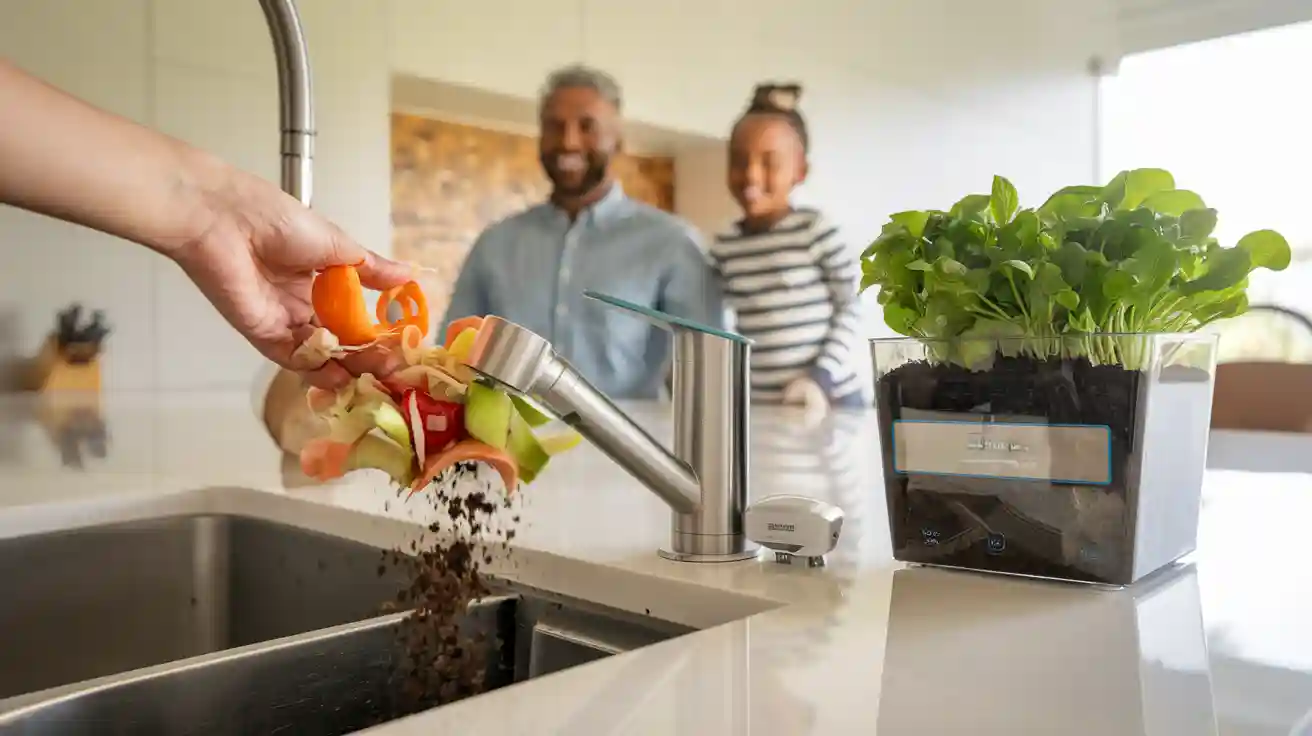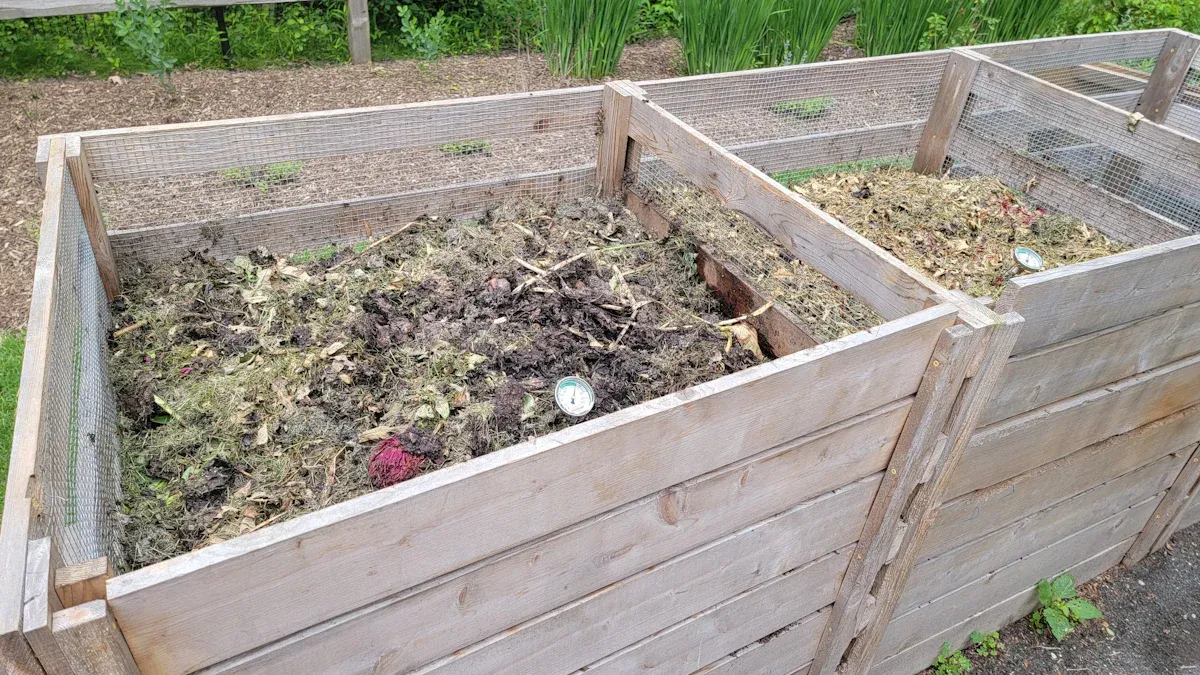
You can use the WL-S3 sink food disposal to turn kitchen waste into valuable compost. This device lets you turn kitchen scraps into compost quickly. Composting with the WL-S3 makes transforming scraps into soil easy. You get rich organic compost and fertilizer from your kitchen food waste. Choose this composting solution to turn scraps into compost and support a greener home.
How the WL-S3 Sink Food Disposal Turns Kitchen Waste into Compost
The Smart Composting Process Explained
You can turn your kitchen food waste into valuable compost with the WL-S3 sink food disposal. This electric compost machine uses heat, aeration, and grinding to break down food scraps quickly. When you place your food waste into the composter, the machine starts by grinding the scraps into smaller pieces. The heating system then dries and sanitizes the material, while constant airflow helps speed up decomposition. You get pre-compost in about 24 hours, which is much faster than traditional composting.
Tip: The WL-S3 electric compost machine lets you compost several batches of kitchen waste each week, making it easy to keep up with daily food scraps.
Here’s a comparison of composting speeds:
| Composting Method | Approximate Time to Finish Composting |
|---|---|
| WL-S3 Electric Compost Bin | About 24 hours to produce dehydrated pre-compost |
| Other Electric Compost Bins | Typically 24 to 48 hours |
| Traditional Composting | Several months up to 1 year |
The WL-S3 countertop compost machine stands out because it lets you manage kitchen waste efficiently and quickly. You can keep your kitchen clean and reduce odors from food scraps.
What Kitchen Waste Can and Cannot Be Composted
The WL-S3 sink food disposal handles most common kitchen scraps. You can compost fruit peels, vegetable trimmings, coffee grounds, eggshells, and small amounts of bread. The powerful 1.0 HP motor and three-stage grinding system allow you to process tougher food items, unlike many other composters.
Here’s a list of what you can compost with the WL-S3 electric compost machine:
- Fruit and vegetable scraps
- Coffee grounds and tea bags
- Eggshells
- Small bread pieces
- Cooked rice and pasta (in moderation)
- Small amounts of cooked food
Note: For best results, cut large scraps into smaller pieces before adding them to the composter.
However, you should avoid putting certain materials into your countertop compost machine. These items can damage the unit or slow down the composting process.
| Materials to Avoid When Using WL-S3 Sink Food Disposal for Composting |
|---|
| Meat |
| Dairy |
| Large bones |
| Plastic |
| Metal |
| Oily foods |
| Hard pits (e.g., peach pits) |
By following these guidelines, you help your electric compost machine last longer and produce better compost. Good kitchen waste management starts with knowing what to compost and what to keep out.
Effectiveness of the Compost Output
When you use the WL-S3 sink food disposal, you get compost that supports healthy soil and plant growth. The compost adds nutrients like nitrogen, phosphorus, and potassium to your garden soil. It also improves soil structure and water-holding capacity, which helps plants grow stronger.
You will notice these benefits when you add compost from your electric compost machine to your garden:
- Soil nutrients increase, especially nitrogen, which helps plants grow.
- Compost boosts organic matter in the soil, making it richer and more fertile.
- Beneficial microbes in the compost improve nutrient cycling and plant health.
- Compost helps soil hold water, so plants stay hydrated longer.
- The composted material is safe and does not raise heavy metal levels in the soil.
Note: For best results, spread a thin layer of compost and cover it with mulch. This combination helps keep the soil moist and supports plant growth, especially during dry periods.
Composting food scraps with the WL-S3 countertop compost machine gives you a steady supply of organic fertilizer. You can use this compost for houseplants, vegetable gardens, or flower beds. Over time, regular kitchen waste composting improves your soil and supports a healthy garden.
Using the WL-S3 for Kitchen Waste Composting
Step-by-Step Operation in Your Kitchen
You can start composting in your kitchen with the WL-S3 electric compost machine. Place your food scraps into the countertop compost machine. Cut food waste into small pieces before adding them. This helps the blades chop efficiently and speeds up composting. Make sure you do not overfill the bin. Follow the recommended fill lines for best results. The machine grinds, heats, and aerates the food waste. You get compost in about 24 hours. You can add food scraps during operation. The electric compost machine adjusts cycle times as needed. Keep the composter plugged in so it can run energy-saving modes and control odors.
Maintenance and Cleaning for Optimal Composting
You keep your electric compost machine working well by cleaning it regularly. Wipe the inside after each batch of compost. Check and clean the blades to prevent jams from food waste. Replace the activated carbon filters every 4-6 months. This helps control odors and keeps your kitchen fresh. Maintain the minimum fill level to support effective microbial activity. The sealed design of the WL-S3 countertop compost machine blocks pests and keeps insects away. You get a hygienic composting experience with no worms or bugs.
| Feature | Traditional Compost Bin | WL-S3 Electric Composter |
|---|---|---|
| Odor | Can produce unpleasant smells | Reduced odors due to advanced ventilation and filters |
| Pest Control | Often attracts flies, insects, rodents | Sealed design prevents pest entry, keeping insects and rodents away |
| Hygiene | May have worms and mess | Hygienic environment with no worms or bugs |
Practical Tips for Best Compost Results
You can improve your kitchen waste composting by following these tips:
- Avoid adding bones, shells, oils, meat, dairy, citrus peels, plastics, and other non-compostable materials. These items cause bad odors, jams, or damage.
- Balance wet and dry food scraps to keep proper moisture levels. This prevents clumping and slow decomposition.
- Do not overfill the electric compost machine. Uneven composting or jams may occur.
- Keep the composter above the minimum fill level for active composting.
- Clean the countertop compost machine often to extend its life.
Tip: Composting with the WL-S3 electric compost machine gives you rich compost for your garden. You reduce kitchen waste and keep your kitchen clean.
Benefits of Composting with the WL-S3 for Home and Garden

Nutrient Value of Compost for Soil and Plants
You can improve your soil by using compost from the WL-S3. This compost acts as a nutrient-rich soil amendment, giving your plants the nutrients they need to grow strong. When you add compost to your garden, you increase the levels of nitrogen, phosphorus, and potassium in the soil. These nutrients help your plants develop healthy roots and leaves. Composting with the WL-S3 creates organic fertilizer that supports gardening all year. You can use this fertilizer for vegetables, flowers, or even houseplants. The compost also helps the soil hold water, so your plants stay hydrated longer. You will see better plant growth and healthier soil with regular composting.
Reducing Kitchen Waste and Environmental Impact
You help the planet by reducing kitchen waste with the WL-S3. Composting your food scraps keeps waste out of landfills. This process lowers the amount of methane gas released into the air. A scientific study shows that using the WL-S3 for kitchen waste composting can reduce your carbon footprint by about 18%. This method cuts down on carbon intensity and supports sustainability. You make a real difference by choosing composting over throwing waste away. Supporting sustainable living becomes easy when you turn waste into compost for your garden.
Cost-Effectiveness and Suitability for Different Households
You save money by making your own fertilizer with the WL-S3. Buying commercial fertilizer can cost a lot over time. Composting at home gives you free, nutrient-rich compost for all your gardening needs. The WL-S3 works well for small apartments, large homes, or families who want a sustainable lifestyle. You can compost waste every day, so you always have fresh fertilizer for your soil. The WL-S3 fits into many types of kitchens and supports sustainable gardening for everyone. You enjoy the benefits of less waste, better soil, and a greener home.
You can turn kitchen scraps into compost with the WL-S3. This compost machine fits in any kitchen and works with just a button press. You get compost quickly, with little effort.
- Simple setup and clear controls make compost easy for you.
- Quiet operation and easy cleaning keep composting stress-free.
FAQ
How often should you clean the WL-S3 compost machine?
You should clean the inside after each batch. Wipe the blades and replace the carbon filter every 4–6 months for best results.
Can you compost citrus peels with the WL-S3?
You should avoid composting large amounts of citrus peels. Small pieces are fine, but too many can slow down the composting process.
What should you do if the WL-S3 starts to smell?
Tip: Check the carbon filter and clean the bin. Remove any non-compostable items. Regular cleaning helps keep your kitchen fresh.


